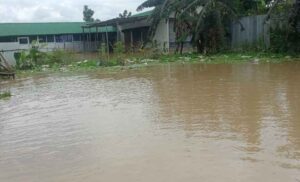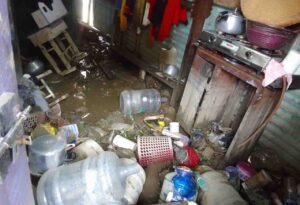“The recent flood in month of July was the first flood that I was experiencing in my life. As the water level rose up chest level at my house, I felt nervous just looking here and there, doing nothing,” lamented by Longjam Binodini, 70 years from Singjamei Mayengbam Leikai.
As her right leg got operated, she was more worried about her movement in the flooded area. Luckily the rescue team carried her on a piggyback and settled her in a relief camp. All their clothes, utensils, cooking gas cylinder and other household items were inundated by the water. She could not carry out any materials from her home. She couldn’t take up any precautionary measures as her house was suddenly under water. She lamented that her house is in a pathetic condition. She is confused from where to start the cleansing process and worried about how to repair her house. She pointed out that poor drainage system, loss of water bodies and other anthropogenic activities are the contributing factors for causing flood in Manipur.
The recent flood in Manipur that occurred in the first week of July this year have severe impact on lives of many people causing casualties, destroying crops, damaging houses and other infrastructure leading many people forced to evacuate their homes leading to temporary displacement. The flood conditions were developed after major rivers such as Imphal, Iril, Nambol and Kongba breached embarkment at different places prompting the mass evacuation of people. Before this second flood, the state witnessed extreme weather events such as hailstorms and flood in last two months. According to media reports over 2000 people have been evacuated and at least two people have lost their lives. In such devastating situation the more sufferers were women, children, PWD and aged-people.
A mother of two sons Minakumari Ningombam, 40 years from Singjamei Waikhom Leikai told IRAP that already her two sons and herself have respiratory diseases with moisture all the time as her house is at low lying area. Moreover, the recent flood has created more health problemsto them with skin diseases too. During the flood period the family had no income, as they had no place to work around. Again, after the flood also, they had a hard living confining their time in cleansing and repairing their house. Minakumari is worried about her son’s studies especially with exams approaching soon as all the note books, textbooks, school uniforms, bags and shoes had been washed away by the flood. While staying at the relief camp also her sons could not study without books. Seeing her son’s innocent face, she felt so disappointed but no means to console their pains. She is more worried as they have no saving and how she will arrange her son’s all lost items. She feels very distressed about how they will resume their family as before.
Another flood victim, Longjam Ongbi Akashini, 80 years, from Singjamei Mayengbam Leikai expressed in grief that the fast flood which she was experiencing in her life make her life more catastrophic. Akashini, who is running her family by selling petrol at roadside in her locality, narrated that all their furniture, and other items were under water during the flood. As she did not experience any flood before and she felt unconscious on seeing the volume of the water that entered in her house. Before the flood, the devastating hailstorm damaged the entire roof of her house. She could not find any words to express her fate being created by the extreme weather events that happened in the state.

A 19 year old girl Leishangthem Sadhana from Singjamei Oinam Thingel, Leirembi Lampak in Imphal West was among the flood victims of the recent flood. She faced many difficulties during the flood in taking care of her ailing parents and other problems too. She wants the government to set up a proper policy to control and manage flood. There were many more people who were suffered in different ways in the recent flood.
Talking to IRAP in this regard, Akoijam Ranjitkumar Singh, Development and Research Officer (DRO), Relief and Disaster Management, Government of Manipur said that the recent flood was L2 flood-state level disaster. People who stay at relief camps were mainly people whose houses were kutcha or with ground-floored house. He said that for any disaster, we need to keep in mind the proverb “Prevention is better than Cure”. We must take as much as possible all the preventive measures for any disasters to reduce its impact. He said that decreasing area of forest and catchment areas of rivers, siltation of water bodies, encroachment, discarding of plastic water bottles in water bodies; drainages etc. are some of the factors for frequent occurrence of flash flood in Manipur.
The government is providing assistance under State Disaster Response Fund (SDRF) accessing its quantum of damage in any disasters which includes Gratuitous relief, Search and rescue operations, Relief measures, Clearance of affected areas, Agriculture, Animal Husbandry, fishery, handicraft/handloom, housing and infrastructure. He appealed people to avail this opportunity. He also appealed everyone to acquire basic self-protection skills to act in any disasters. Pointing out some preventive measures, Mr Ranjitkumar expressed that people need to update themselves the weather-related warning predicted by IMD, disaster resilient comments, to carry important documents, medicine and some foods with themselves etc.

Explaining about the phenomenon of flash flood in Manipur, Dr. Likmabam Sanjoy, Department of Environmental Sciences, Dhanamanjuri University, Manipur opined that loss of wetlands and other water bodies, black topping, reducing the size of drains, RCC flooring, construction taking places in paddy fields and rivers, deforestation, siltation, illegal encroachment and other anthropogenic activities are the main contributing factors for causing flash flood in the state. Pointing out the importance of wetlands in controlling floods, Dr Sanjoy said that as the wetlands (flood-regulators) and other water bodies are dying day by day, it fails to absorb and store excess rainfall and river overflow resulting to water movement through the landscape causing frequent flash flood.
The traditional homestead fencing by bamboo plants and mud wall (palli) also help in controlling the flood in and around their houses. In earlier times mainly Saneibi Wa (a variety of bamboo) is planted around the house as a wind breaker to protect from cyclones. Promoting and preserving such system will also help in regulating natural disasters. He further said that due to the effect of climate change, the average amount of rainfall pattern has been changed. Due to various human activities, heavy rainfall occurs at a particular period of time and place. Dr. Sanjoy appeals everyone to be a responsible citizen to conserve our water bodies in their own localities. Let us plant more trees, avoid bad habits of throwing pollutants into the water bodies, illegal constructions and other activities that will disturb the environment.
Considering the vital role played by water bodies in controlling flood and overall environmental health, proactive and immediate conservation and preservation efforts are essential. It can protect both human and natural communities. Thus, it will help in reducing the impact of flood on vulnerable and marginalized communities. To control the impact of floods and manage flood risks effectively, a comprehensive approach that includes prevention, preparedness response and recovery is necessary.












